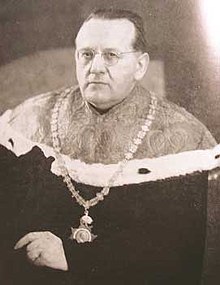Eduard Pernkopf
| Eduard Pernkopf | |
|---|---|

Eduard Pernkopf in academic regalia.
|
|
| Born |
24 November 1888 Rappottenstein, Austria-Hungary |
| Died | 17 April 1955 (aged 66) Vienna, Austria |
| Nationality | Austrian |
| Fields | Anatomy |
| Alma mater | University of Vienna |
| Known for | Topographische Anatomie des Menschen, anatomical atlas possibly derived from executed Nazi political prisoners |
Eduard Pernkopf (November 24, 1888 – April 17, 1955) was an Austrian professor of anatomy who later served as rector of the University of Vienna, his alma mater. He is best known for his seven-volume anatomical atlas, Topographische Anatomie des Menschen (translated as Atlas of Topographical and Applied Human Anatomy; often colloquially known as the Pernkopf atlas or just Pernkopf), prepared by Pernkopf and four artists over a 20-year period. While it is considered a scientific and artistic masterpiece, with many of its color plates reprinted in other publications and textbooks, it has been in recent years dogged by questions about whether Pernkopf and the artists working for him, all of them ardent Nazis, used concentration camp inmates or condemned political prisoners as their subjects.
Pernkopf was born in 1888 in the Lower Austria village of Rappottenstein, near the border with Bavaria. The youngest of three sons, he seemed to be considering a career in music upon his completion of the Gymnasium in Horn. However, the death of his father, the village's doctor, in 1903 led him to pursue medicine instead, as his father's death caused the family considerable hardship that a career as a physician was more likely to reverse.
He began his studies at the University of Vienna's medical school in 1907. During his time there he became a member of the Student Academic Fraternity of Germany, a student group with a strong German nationalist persuasion. As a student he had worked under Ferdinand Hochstetter, director of the university's anatomy institute. Hochstetter became his mentor and one of his strongest influences. In 1912 he received his medical degree.
For the next eight years he taught anatomy at various institutions in Austria. He served in the military as a physician for a year during World War I. In 1920 he returned to Vienna to work as one of Hochstetter's assistants, lecturing to first- and second-year students about the peripheral nervous and cardiovascular systems.
...
Wikipedia
